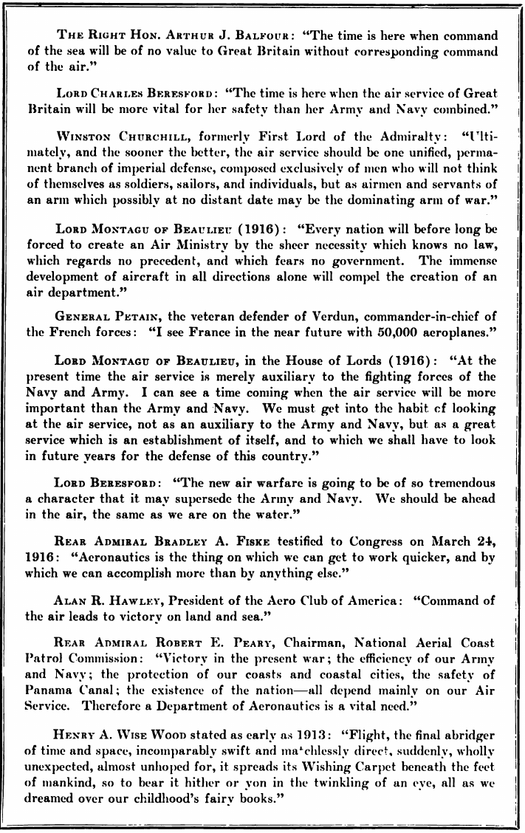Difference between revisions of "Military"
(add quotation from Benjamin Franklin to John Ingenhousz 16-Jan-1784 and rearrange quotations chronologically) |
(add big honking blog of quotations at bottom of page) |
||
| Line 24: | Line 24: | ||
<blockquote>At heart military dominance demands ''height''. With height comes ''view'', with view comes ''awareness'', and with awareness comes the ''ability to undertake decisive action''. Since earliest times, from the days of the scout perched on a horse on top of a hill, military leaders sought means of reaching across intervening terrain to learn about an enemy and his intentions, and if possible, to strike at him. Wellington, victorious over assorted armies at Seringapatam at Assaye in India, over various of Napoleon's marshals in Spain, and finally over Napoléon himself at Waterloo, famously remarked in 1845, "I have been passing my life in guessing what I might meet with beyond the next hill, or round the next corner." Early aviators recognized that the vantage point conveyed by flight offered tremendous possibilities of assuaging the frustration Wellington expressed.</blockquote> | <blockquote>At heart military dominance demands ''height''. With height comes ''view'', with view comes ''awareness'', and with awareness comes the ''ability to undertake decisive action''. Since earliest times, from the days of the scout perched on a horse on top of a hill, military leaders sought means of reaching across intervening terrain to learn about an enemy and his intentions, and if possible, to strike at him. Wellington, victorious over assorted armies at Seringapatam at Assaye in India, over various of Napoleon's marshals in Spain, and finally over Napoléon himself at Waterloo, famously remarked in 1845, "I have been passing my life in guessing what I might meet with beyond the next hill, or round the next corner." Early aviators recognized that the vantage point conveyed by flight offered tremendous possibilities of assuaging the frustration Wellington expressed.</blockquote> | ||
| + | [[File:1917 - Textbook of Naval Aeronautics - Quotations on Air War.png|thumb|525px|Quotations on air power in war collected during [[World War I]] by [[Henry Woodhouse]] and printed at the front of his 1917 ''[[Textbook of Naval Aeronautics]]''.]] | ||
{{Techtype | {{Techtype | ||
Revision as of 15:23, 10 December 2017
Chalais-Meudon, French military installation which advanced dirigible technology and produced La France.
Aerodrome A — Langley project sponsored by U.S. War Department
Some publications:
- Fullerton, 1893, Some Remarks on Aerial Warfare
- Ader, 1907, La Première Étape de l'aviation militaire française
- Lafon, 1916, Les armées aériennes modernes
- Lanchester, 1916, Aircraft in Warfare
- Lin, 1932, Aeronautical Law in Time of War (focuses on events and laws before 1914)
Following the first demonstrations of ballooning, Benjamin Franklin speculated in a 1784 letter:
Convincing sovereigns of the folly of wars may, perhaps, be one effect of it, since it will be impracticable for the most potent of them to guard his dominions. Five thousand balloons, capable of raising two men each, could not cost more than five ships of the line; and where is the prince who can afford so to cover his country with troops for its defence, as that ten thousand men descending from the clouds might not in many places do an infinite deal of mischief before a force could be brought together to repel them?
Coxwell, 1887 dates military aeronautics to the French Revolutionary era, referring maybe to the Committee of Public Safety (p. 168):
The inventive genius of the French may be traced no less than their intrepidity in their early efforts to apply the balloon to purposes of warfare.
In the year 1793, a scientific committee was formed in Paris with this object, when it was suggested that balloon should be used both for attack and defence, and for ascertaining the movement of armies in the field, and to get at the strength of fortified places.
Here was a clear and comprehensive plan for a new departure in military science which the leading nations of Europe have been slow in imitating.
Coxwell also mentions the use of a reconnaissance balloon by the Compagnie d'aérostiers at the Battle of Fleurus in 1794 (p. 173).
Hallion, 2003, p. 296:
At heart military dominance demands height. With height comes view, with view comes awareness, and with awareness comes the ability to undertake decisive action. Since earliest times, from the days of the scout perched on a horse on top of a hill, military leaders sought means of reaching across intervening terrain to learn about an enemy and his intentions, and if possible, to strike at him. Wellington, victorious over assorted armies at Seringapatam at Assaye in India, over various of Napoleon's marshals in Spain, and finally over Napoléon himself at Waterloo, famously remarked in 1845, "I have been passing my life in guessing what I might meet with beyond the next hill, or round the next corner." Early aviators recognized that the vantage point conveyed by flight offered tremendous possibilities of assuaging the frustration Wellington expressed.

| Enclosing categories | Simple tech terms |
|---|---|
| Subcategories | Projectile |
| Keywords | |
| Start year | |
| End year |